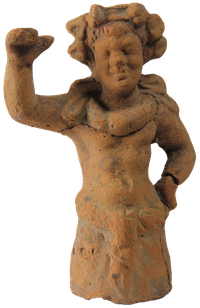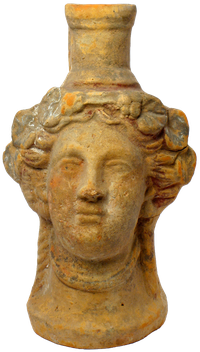Black Sea Region
 |
 |
 |
 |
In 1908, Bruno Sauer (1861-1919) acquired numerous pieces from the "possession of Mr. A. Vogell"[1] for the Giessen Collection of Classical Antiquities, including terracottas containing female protomes, a Hellenistic female head vessel and a small satyr figurine. Arnold Vogell had lived for a long time in the Tsarist Empire as a merchant in Nikolajeff, the old Olbia on the north coast of the Black Sea. This is how numerous ancient finds[2] that he had acquired in southern Russia ended up in his collection.
Since the later 7th century BC, Greeks had settled in the northern coastal region of what is now called the Black Sea (in ancient times: Pontos Euxeinos = the hospitable sea) and had achieved some prosperity there[3]. As the finds of vases and pottery fragments show, there were close trade relations with Ionia, especially with Rhodes and Chios. Attic pottery was added from the end of the 6th century[4]. In the 5th century BC, the Bosphoran Empire emerged, a dynastically structured territorial state[5] that united the Greek and local populations on both sides of the Cimmerian Bosphorus, between the eastern Crimea and the Taman Peninsula[6]. The capital Pantikapaion, today's Kerch, was probably founded by Miletus in the 6th century BC[7]. Large quantities of grain and fish, leather and wool, wood, precious metals and slaves[8] reached Athens by ship, which in turn supplied luxury items, namely wine, olive oil and painted pottery. Especially in the second half of the 4th century BC, Athens must have covered most of its grain needs by importing from Pantikapaion[9]. In return, it exported the Kerch vases, named after their main place of discovery, a type of Attic vessel whose shape and motifs were designed to suit the taste of the addressees[10].
The first terracottas also came from Ionia[11] (Samos, Rhodes), followed by imports from Corinth and Attica. A little later, local workshops took up the production of clay figures. They imitated their models at first, only to modify them later[12]. As in the core area of Hellas, statuettes of enthroned women[13], korai (girl figures)[14], female half-figures[15], protomes[16] and naked youths[17] were produced. From the 4th century BC and in the Hellenistic period, herms[18] and statuettes related to Aphrodite[19] and the wine and theatre god Dionysus[20] became more frequent. A regional speciality are marionettes, clay figures with human or demonic heads and separately formed legs, which, with the exception of the movable hip joints, are made rigid throughout, without jointed knees[21].
Today, public interest in the ancient cities of the northern Black Sea coast tends to focus on the nearby Scythian tombs, which, in addition to terracottas and vases, also contain rich gold treasures and precious jewellery[22].
[1] J. Boehlau, Griechische Altertümer südrussischen Fundorts aus dem Besitze des Herrn A. Vogell, Karlsruhe (Cassel 1908) 54 no. 532 pl. 8, 2; A. Klöckner – M. Recke (eds.), Gönner, Geber und Gelehrte. Die Gießener Antikensammlung und ihre Förderer (Nürtingen 2007) 24-27; M. Recke, Die Klassische Archäologie in Gießen.100 Jahre Antikensammlung (Gießen 2000) 36-38 incl. notes 129. 130.
[2] Boehlau ibid. 2; Klöckner – Recke ibid. 24; J. Merten, Aus dem Nachlass von Erich Gose. Ein unbekanntes Werk von Arnold Vogell über das antike Olbia, TrZ 61, 1998, 331-342.
[3] J. Boardman, Greek Archaeology on the Shores of the Black Sea, Archaeological Reports 1962-63, 34-51.
[4] J. Boardman, Kolonien und Handel der Griechen (München 1981) 286.
[5] Herodot, Historien 4, 11. A. Horneffer – H. W. Haussig – W. F. Otto (Stuttgart 1955); M. Pfrommer, Am Schnittpunkt vieler Welten. Die Griechenstädte der nördlichen Schwarzmeerküste als Stätten kultureller Begegnung zwischen dem 4. und dem 1. Jahrhundert v. Chr., Nürnberger Blätter zur Archäologie 9, 1992-93, 9-11.
[6] F. Fless, Griechische Kultur im nördlichen Schwarzmeergebiet – Das Bosporanische Reich, in: Die griechische Klassik. Idee oder Wirklichkeit (Berlin 2002) 575-578.
[7] Strabon, Geographica VII 4, 4. A. V. Podossinov, Am Rande der griechischen Oikumene, in: J. Fornasier – B. Böttger (eds.), Das Bosporanische Reich (Mainz 2002) 21-29; Der kleine Pauly I (1964) Sp. 931-933 s. v. Bosporanum Regnum (Chr. Danoff).
[8] H. G. Gundel, Die Krim im Altertum (Heidelberg 1942) 122 f.; G. M. Boháč, Kertscher Vasen (Prag 1958) 130 f.; K. Schefold, Untersuchungen zu den Kertscher Vasen (Berlin 1934); Boardman ibid. 1962-63, 45.
[9] Demosthenes XX, 31; Pfrommer ibid. 1994, 10.
[10] M. Langner, Athen in der Fremde: Die Athenisierung der griechischen Welt, in: U. Kästner – M. Langner – B. Rabe (eds.), Griechen, Skythen, Amazonen (Berlin 2007) 18; A. A. Trofimova (eds.), Greeks on the Black Sea (Los Angeles 2007) 147-280.
[11] J. Bouzek, Terracottas, in: Studies of Greek Pottery in the Black Sea Area (Prag 1990) 103-109; M. M. Kobylina, Terakotovyje statuėtki Pantikapeia i Phanagorii (Moskau 1961) 27 f. and 40 pls. 1, 2 and 4, 2. I owe translations to E. Kunz, Giessen and P. Krasznai, Budapest.
[12] Bouzek ibid. 105 f. ;
[13] M. M. Kobylina, Terrakoty Severnogo Pričernomor’ja. Teil Č. 1 / 2 (Moskau 1970) 83 pls. 27, 1-5.
[14] M. M. Kobylina, Terrakotovye statuėtki Teil Č. 3 Pantikapej (Moskau 1974) 7 f. pl. 3, 1.
[15] Kobylina ibid. Teil Č. 1 / 2, 1970, 79 pl. 21; id. ibid.Teil Č. 3 1974, 18 pls. 6 and 7, 2; id., Pridonye i Tamankij Poluostrov Teil Č. 4 (Moskau 1974) 45 pl. 51, 5 pl. 52, 2.
[16] Kobylina ibid. Teil Č. 1 / 2, 1970, 34 pl. 10, 1. 2; id. Teil Č. 4, 1974, 33 f. pls. 37. 38 .
[17] Kobylina ibid. Teil Č. 3 1974, 28 pl. 30, 5.
[18] Kobylina ibid. Teil Č. 4, 1974,19 pl. 13, 3; 49 57, 4.
[19] Ibid. 18 pl. 13, 4; 28 pl. 31, 2
[20] Boardman 1962-63, 43.47; Bouzek ibid. 1990, 103. Kobylina ibid. Teil Č.4, 1974, 19 pl. 14, 4; 26 pl. 24, 3; 38 pl. 44, 4. 12; 39 pl. 45, 2. 3.
[21] A. M. Butyagin, Barbarian Art in the Cities of the Northern Pontic Region, in: Trofimova ibid., 65-69 fig. 9.2 and p. 205 f. nos. 104. 105; P. C. Bol – E. Kotera, Bildwerke aus Terrakotta, Liebieghaus Frankfurt am Main (Melsungen 1986) 227; F. W. Hamdorf, Die figürlichen Terrakotten der Staatlichen Antikensammlungen München 2 (Lindenberg im Allgäu 2014) 664 f.; A. Derewitzky – A. Pavlowsky – E. von Stern (eds.), Das Museum der Kaiserlich Odessaer Gesellschaft für Geschichte und Altertumskunde. Lieferung 1 und 2 Terracotten (Frankfurt a. Main – Odessa 1897 und 1898) 31-35.
[22] Boardman 1981, 297; J. Fornasier – B. Böttger (eds.), Das Bosporanische Reich (Mainz 2002) 10;
Trofimova ibid. 147-280.
